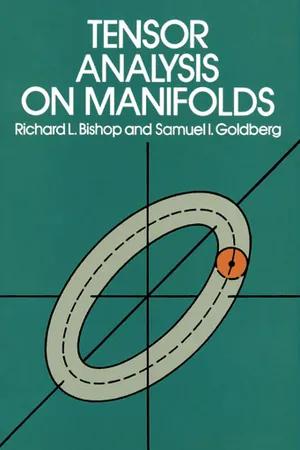
- 288 pages
- English
- ePUB (mobile friendly)
- Available on iOS & Android
Tensor Analysis on Manifolds
About this book
"This is a first-rate book and deserves to be widely read." — American Mathematical Monthly
Despite its success as a mathematical tool in the general theory of relativity and its adaptability to a wide range of mathematical and physical problems, tensor analysis has always had a rather restricted level of use, with an emphasis on notation and the manipulation of indices. This book is an attempt to broaden this point of view at the stage where the student first encounters the subject. The authors have treated tensor analysis as a continuation of advanced calculus, striking just the right balance between the formal and abstract approaches to the subject.
The material proceeds from the general to the special. An introductory chapter establishes notation and explains various topics in set theory and topology. Chapters 1 and 2 develop tensor analysis in its function-theoretical and algebraic aspects, respectively. The next two chapters take up vector analysis on manifolds and integration theory. In the last two chapters (5 and 6) several important special structures are studied, those in Chapter 6 illustrating how the previous material can be adapted to clarify the ideas of classical mechanics. The text as a whole offers numerous examples and problems.
A student with a background of advanced calculus and elementary differential equation could readily undertake the study of this book. The more mature the reader is in terms of other mathematical knowledge and experience, the more he will learn from this presentation.
Frequently asked questions
- Essential is ideal for learners and professionals who enjoy exploring a wide range of subjects. Access the Essential Library with 800,000+ trusted titles and best-sellers across business, personal growth, and the humanities. Includes unlimited reading time and Standard Read Aloud voice.
- Complete: Perfect for advanced learners and researchers needing full, unrestricted access. Unlock 1.4M+ books across hundreds of subjects, including academic and specialized titles. The Complete Plan also includes advanced features like Premium Read Aloud and Research Assistant.
Please note we cannot support devices running on iOS 13 and Android 7 or earlier. Learn more about using the app.
Information

Table of contents
- Cover
- Title Page
- Copyright Page
- Preface
- Contents
- Chapter 0 Set Theory and Topology
- Chapter 1 Manifolds
- Chapter 2 Tensor Algebra
- Chapter 3 Vector Analysis on Manifolds
- Chapter 4 Integration Theory
- Chapter 5 Riemannian and Semi-riemannian Manifolds
- Chapter 6 Physical Application
- Bibliography
- Index